Wanderstop review
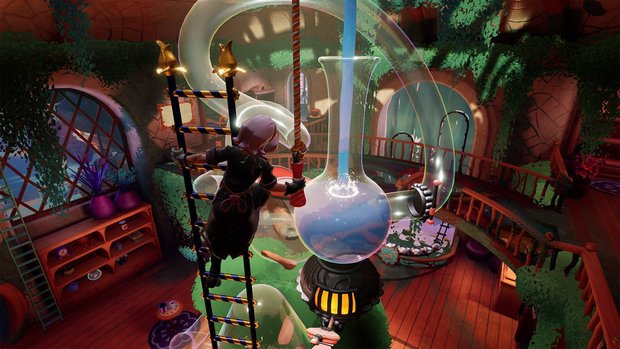
- 0 Comments
Cozy tea shop sim might not be everyone’s cuppa, but it’s a thoughtful reminder to slow down and drink in what’s important in life
One of the immediately obvious, humorous, and ultimately emotionally impactful realizations in playing Wanderstop, is that the protagonist, Alta, does not want to be the star of this game at all. She is a talented arena fighter! She wants to be defeating her foes through her skill with the blade, raising it high over the supine bodies of her defeated foes, and receiving the roared approbation of the crowd! She wants, in fact, to be the hero of a rogue-like sword combat game, using skill points won from her victories to improve her combat skills and improving her weapons, rising in the ranks to become the greatest fighter of all time!
But Alta is stuck in a cozy tea-making game where she spends her time farming, foraging for supplies, and fulfilling requests for different kinds of tea from customers who wander by the titular tea shop. While recovering in a remote woodland area, she’ll reluctantly learn to make different kinds of tea, getting to know her visitors and establishing relationships with them.
Quite reasonably, she hates being in Wanderstop… Back to the arena! Become the greatest fighter of all time! But… here she is. Making tea. For some reason she can’t even pick up her sword anymore, and when she ventures back into the forest to seek Master Winters, who she hopes can train her to overcome her losses and become the fighter she longs to be… she falls unconscious and winds up back at the tea shop with its owner, the friendly, good-natured Boro.
But this is actually exactly what she needs. She has serious mental issues, really. She needs to chill out. She exhausted herself in pursuit of combat glory. Is making tea so bad?
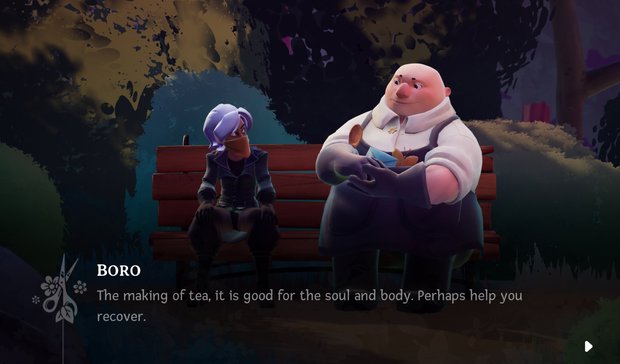
One of the game’s developers is Davey Wreden, who was involved with both The Stanley Parable and The Beginner’s Guide. This game is nothing like either of them. It’s creative, for sure, but mostly it’s a very conventional videogame, with some interesting divergence from the usual form. I think in some ways the game is a commentary on the AAA game industry and the typically long hours it demands; in some ways it’s saying, “stop sleeping under your desk to create another inane shooter, and maybe smell the tea and create a cozy indie game.” Like this one. The moment-to-moment gameplay is very casual; the only real connection to Wreden’s previous work is in the intellectual discontinuity between the character’s motivations and the game she inhabits. But that’s interesting.
Wanderstop is playable with mouse-and-keyboard, but it is a 3D navigation game better played with a controller, even on PC. The area closest to the house is a fairly manicured garden, where you grow plants; farther out is a wilder area, with many trees, bushes, and flowers. Out there grow tea bushes and mushrooms, and you spend a fair bit of time running about the environment harvesting them both. Tea leaves get dumped at a station where over time they transform into usable tea balls.
To make more and different kinds of tea, you’ll need to grow your own ingredients. You are granted several seeds early; if you deploy three seeds of the same color in a row, and water them, you can harvest more seeds of that color. Seeds planted in a triangular pattern (a hex grid appears to facilitate this) allow you to harvest fruit, depending on the color of the central seed and those around it. The game supplies a “Field Guide” you can bring up; at the start it shows which seed color you need to plant for a particular fruit in the center, but to reveal a recipe you need to experiment with planting differently colored seeds.
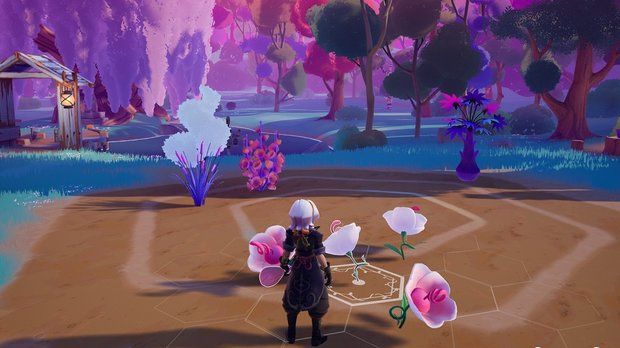
So yes, there is a farming mechanic, but unlike most games that have farming, it’s not a grind as you are not farming over and over to make money. It’s not Harvest Moon, in other words. I need this fruit to satisfy this tea request? Alrighty then, bring up the Field Guide and figure out how to make that fruit. There is a little bit of busywork involved: You run around to refill your watering can at pond pumps and to harvest the fruit you want, but still, far less grindy than most farming games.
In each chapter, you encounter characters who want some kind of tea. Often, how to fulfill their requirements isn’t immediately obvious; e.g., they want a mint flavor, so you have to look at your book to see which fruit is minty, farm it, and use it in the tea. Customer requests are also recorded in a section of your Field Guide, so no danger of forgetting what they want.
Tea-making is a minigame in its own right. In the middle of the shop is a rather large construction: Climb a ladder, pull a cord to fill a huge glass vial with water, stomp on a bellows to heat it, turn a valve to dispense the boiling water into a brewing chamber with an open flap at the top, toss a tea ball and other ingredients into the chamber, then open another valve to let the tea flow into the dispenser. Get off the ladder, put a mug under the dispenser tube, then pull a cord to fill up the mug. Grab the mug and find the customer who wanted this tea.
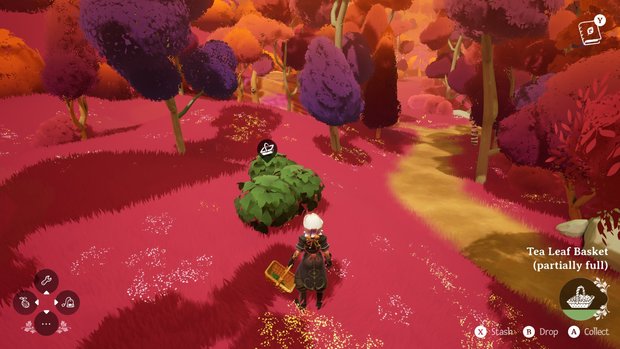
It’s actually a pretty engaging minigame, largely because Alta’s animations as she performs the task are smooth and well-executed, as is the flow of water through the system and the fact that the tea’s color (sometimes multi-hued) varies with the ingredients you use. It does get a bit repetitive, but in each chapter you receive only a handful of tea requests, so as with the farming aspect of the game, it doesn’t get too tedious. While the game space is fairly large, a key press displays the direction of characters from your current location, in the form of small portraits around the screen edge, so finding the right customer to deliver the tea to is not too difficult.
In fact, the only grindy portion of the game is tea-gathering. You run all over the outdoors area, looking for tea bushes, then swiping at them with a basket to gather the leaves. It takes a dozen or so bushes to fill your basket, and tea bushes generally appear only two or three at a time, so filling it takes a while. A full basket eventually yields two tea balls, and one gets used with every batch of tea, so you need to run around outside frequently.
Most character dialog is entirely in text, as only Alta is voiced. And even then, only during forest sequences, cutscenes, and when she drinks tea. Drinking tea provides interesting and useful backstory about her character, but she has to fill a cup, find a place to sit down, and muse. Each tea-making sequence provides at least enough for two, so every time you make tea, even if primarily for another character, you should make at least two mugs. Drink one, listen to the dialog, then pour another to serve your customer and take it to them.
There are two other aspects of gameplay: sweeping leaf piles, and cutting back weeds. Both are actually optional – you can avoid doing either task – but collectibles, small and mostly fun objects you can bring back to the house and put on shelves, drop occasionally if you do engage in these activities. The weeds are gnarled barren stems, and I actually found myself clipping them often because they were so damned ugly and I wanted them gone. Optional, but kind of an interesting emotional response (on my part, anyway) to a non-essential game task.
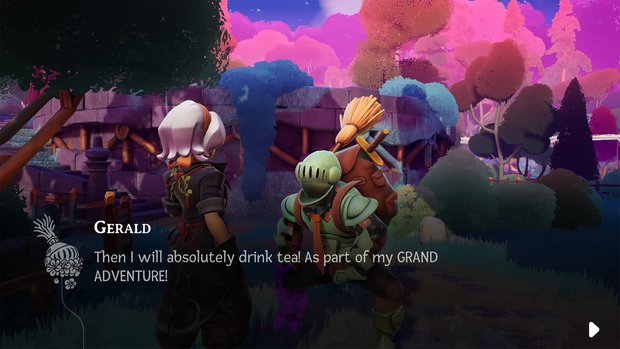
One aspect I didn’t appreciate: Between each chapter, collectibles disappear, as do previously established plants. The plants are not a huge issue, as each new chapter gives you plants to harvest seeds from, so you can re-establish your garden. The disappearance of collectibles seems like a lost opportunity. I collected a lot (weeds! Cut them down!), and liked seeing them on my shelves, and felt sad when they went away. There’s an obvious opportunity for an achievement here (earn all collectibles), but I'm not sure the shelves would hold everything you can collect.
The game is 3D, albeit fairly low-poly, brightly and attractively lit, with the palette changing with each of its five chapters, depending on Alta’s mood, the weather, and lighting conditions. Between chapter 1 and chapter 2, things get much more colorful; in chapter 3, Alta’s depression makes everything gray. Character animations are diverse and well-rendered. Small semi-random perturbations of flora provide the illusion of a breeze and prevent them from looking static. In general, the world is pretty beautiful, and lively with nice touches like butterflies and colorful mushrooms.
There isn’t much in the way of fauna: pluffins – plump waddly birds – move about the environment, and occasionally steal things from you. If you want whatever it is back, you can pick them up and shake them, which makes them drop what they stole. You can also pick them up and pat them, which has no gameplay effect whatsoever, but cozy game, right?
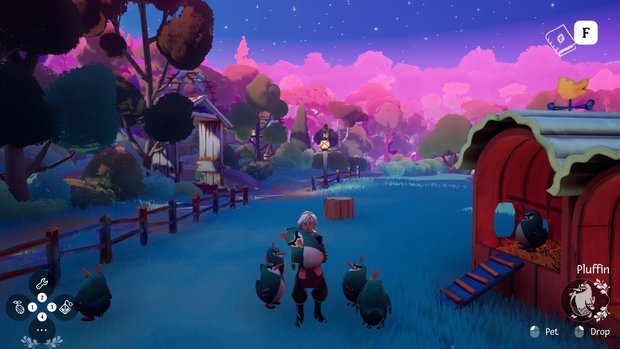
There’s a fair bit of diversity to the music; all of it fairly chill, but ranging from what sounds like chamber music to trance techno. Some of it is tied to action (collecting tea is a somewhat faster-paced tune), but a lot seems to be randomly selected tracks. Additionally, in the house there’s a kind of radio with three “stations”: cat, dog, and cow. Each has a different style, but this only affects music heard in the house. Occasionally the radio starts bouncing and emitting static; you can ignore this if you want, or else tune to another station to restore the music.
There are the usual footsteps (that vary depending on what you’re walking on), but not much in terms of ambient audio. There are plenty of audio stings related to actions (swiveling the ladder about the tea station, pouring tea, running through bushes, performing an idle animation and so on). In general, if you’re okay with the coziness of the game, you’ll probably be perfectly okay with the coziness of the soundscape as well.
The overarching narrative is, of course, all about Alta’s driven nature and Boro’s attempt to help her relax and come to grips with the fact that she’s kind of a monster who needs to maybe give up centering her life around violence. But each of the characters Alta meets (and serves tea to) has their own small story, revealed through dialog, and each has their own personality. The writing is quite good, and while there isn’t a great deal of depth in Alta’s character interactions (except with Monster, a small girl with multi-colored braids who becomes fixated on Alta and decides she wants to become an arena fighter), they provide a nice diversion from tea-making.
An amusingly ironic aspect is that Boro wants Alta to become less obsessed with working hard and achieving victory, but the actual gameplay involves you running about, foraging and farming, brewing tea, all to complete tasks on your quest list. Boro may encourage you to chill out, and I suppose you could spend time just enjoying the scenery and drinking tea, but actual gameplay is “what’s next? Okay, do that thing on the list.” So yeah, completing the game means working hard and achieving victory… so in a way, gameplay undermines the ostensible lesson of the game.
The first chapter is basically the tutorial, while later ones add some complexity to tea brewing (e.g., use only hot, not boiling water, or a complex system of ingredients involving mushrooms you can forage for in addition to tea leaves). Each ends in a sequence whereby you go to commune with a nearby shrine under Boro’s guidance, with a cutscene resulting. Not every quest needs to be completed, but the game gives no guidance about which are essential and which are not, though you’re advised to complete other quests if some are giving you trouble – you may be able to progress without them.
Final Verdict
It took me about 14 hours to complete the game, but I’m sure you could do it in maybe 10, if you ignored non-essential tasks (mutter damn weeds mutter). In general, I like cozy games, and the discontinuity between Alta’s desires and the requirements of the game I found an interesting and tasty divergence from the nature of most cozy games. There isn’t a lot of puzzle-solving here, other than consulting your Field Guide and trying to figure out what ingredients would fulfill the tea requests of your customers. This involves some reading and insight, but it’s not exactly brain-teasing. It’s not a typical point-and-click adventure game, for sure, but I found Wanderstop to be good fun, and there is a narrative spine. It’s worth a spin, unless “cozy” really isn’t your thing.
Hot take
Wanderstop is a cozy game of tea-making, featuring quirky customers and a protagonist who, amusingly, would rather be sword fighting than stuck here, making tea. In general, if you enjoy farming/crafting games and admire a bit of a narrative kick, you’ll enjoy it.
Pros
- Attractive graphics and diverse, comforting music
- Farming and tea-making systems minimize grind
- Quirky customers, each with their own personality
- Discontinuity between the actual gameplay and the encouragement to chill out adds a bit of narrative spice
Cons
- Foraging for tea does get a bit tedious at times
- Collectibles and farmed plants disappear between chapters
Greg played his own copy of Wanderstop on PC.











0 Comments
Want to join the discussion? Leave a comment as guest, sign in or register.
Leave a comment